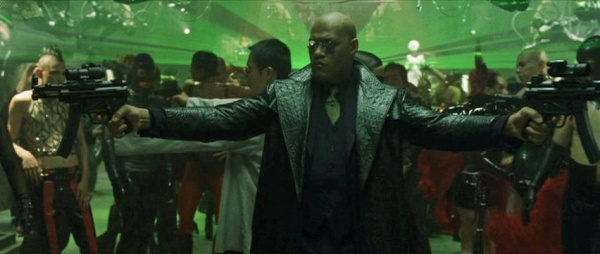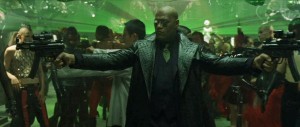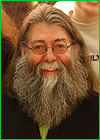
 Archival interview with Peter Robb-King from the official Matrix website.
Archival interview with Peter Robb-King from the official Matrix website.
MATRIX: The last time we spoke was in Alameda; how has Australia been?
PETER: The year in Australia has been an extraordinary journey. These films have been a bit like running a marathon – which I’ve never done – but in a marathon you continue, you get to a certain point, you hit a wall, and you have to get through that. You carry on and keep on going and eventually at the end of 26 and a half miles, you make it. That’s what this feels like; it feels like a journey where there have been very high points, lower points, difficult situations to get through and then eventually coming out at the end and the films are over. What I find interesting is that this is a journey none of us will ever experience again. People who haven’t done a lot of movies and came onto this one for their first film think this is what movie making is about, and how it’s going to be in the future, but they won’t be because these sorts of jobs are very rare. I don’t think we’ll see another one like this for a very long time. It has certainly been very interesting and challenging.
I think there are 150 sets here, and that in itself is mind boggling because that’s an amazing amount of sets to build and work on, as well as have access to and be able to maneuver the time frame to enable those to be built and finished. On many occasions there have been sets on one stage that are interchangeable or being moved around in a night.
MATRIX: With this production going on for so long, does it almost feel like different movies?
PETER: I guess on some level we’ve made probably a minimum of 4 normal movies in time, and many more small movies, and we certainly have made the equivalent of three major movies even though we’ve only made two. Having said that, we’ve also done the game, which in itself was another interesting side facet of this production.
MATRIX: There has been an immense amount of behind the scenes activity; how did it go for you?
PETER: It went well, but there was obviously a lot to do. We had to deal with a lot of organizing and a lot of teamwork, but generally it went very well and was a great achievement because the time frame was very tight. Although we had a long schedule, there was a lot to do per day. In the schedule we had a lot of actors we had to get ready and often, because of the way the film was structured, we had a lot of actors we already established in Alameda, so we tried very hard to keep the same people with them throughout the picture. When we came to Australia we didn’t bring everyone in the Makeup Department from America, but we did have a very, very large crew here; we used a lot of locals, which was fantastic for them and for us.
MATRIX: How was the shift from one crew to another?
PETER: We used the notes we had made in the USA and there were some people who crossed over, so between myself and Maggie [Fung, Key Makeup Artist] we tried to keep a balance, dividing up the actors we couldn’t do to other Makeup Artists; and there were a lot of new actors as well. We had a baby born in the department during the year: Margaret [Aston, Makeup Artist] who joined us at the beginning of the Australian shoot found out she was pregnant a few months into filming, and she has had the baby before the film is even finished. We actually got a nucleus of people who stayed with us, which was great and a nice way to be so you can keep continuity and teamwork.
MATRIX: What was one of the most challenging scenes you achieved in Australia?
PETER: Initially the Smith street scene [Matrix City Street] was enormous for makeup and hair, because of the numbers involved because of the cloning, and because of the situation we were being asked to achieve. That was great because it worked; we made it work against all the odds because it was right up to deadline. A lot of departments were involved and we all came together and I think everyone was very happy because it had never been done.
That scene evolved through meetings and opportunities to see if we could use masks, to see if we could use dummies, and to see if we could articulate those dummies. The Art Department was involved in it, as was the Prop Manufacture Department and other departments including the Hair and Makeup Departments. The scene required a lot of prosthetics, a lot of wigs, and a lot of new ideas that had never been done before. We weren’t just making a lot of clones, we were making people stand in torrential monsoon-like rain – so that was the biggest challenge by far. One hundred dummies were made, and fifty people operated those dummies, all wearing wigs and prosthetics to look like Agent Smith.
MATRIX: Is there a real challenge to making people look alike?
PETER: Yes, to make people look alike is actually impossible – we have twins in the picture and they don’t look alike. They look alike to most people, but we know them because we’ve worked with them for months and they are different; they’re different in a very minor way. If you wanted to make clones normally, you’d use twins, but you can’t have that many twins of the same genetic makeup. What is interesting is that even with the Twins there were differences, so to actually make somebody else who’s not a twin to look like someone is asking for a miracle.
When you are breaking people down for Zion or any of the other broken down scenes, it’s interesting doing that makeup because it’s not that quick and there are a lot of processes you go through, but you’re able to achieve that result in various ways, so it’s not as meticulous. If you’re trying to make a double, there are different processes that happen.
MATRIX: How extreme did the makeup and prosthetics get?
PETER: It got very extreme and very graphic, which was very good for us because there were a lot of prosthetics used and we were able to do major injuries. These injuries were made up to be featured, which was great because nobody wanted them to be hidden in the background. Keanu [Reeves, Neo] gets blinded, and it was a major interest to achieve that without causing any problems with the eyes. He had to be totally blind, which was a big situation to have the eyes covered for so many hours. We obviously had to check out the way we planned to do it, as well as do medical checks.
 MATRIX: Was there more than the bandage?
MATRIX: Was there more than the bandage?
PETER: There was more than the bandage; there was a whole sequence where the injuries occurred, and you see that injury for quite a few scenes before it’s bandaged. When it was bandaged there was a bit of film or artistic license there, but when it wasn’t bandaged you could see the full effect, which was a challenge to achieve. We shot a lot of the bigger scenes – a lot of the Siege scenes – at the end of the movie where the time frame was already getting tighter and it was hard because you were running faster to catch up all the time. Whereas looking back at Alameda when we were on the freeway, it seemed like there was a lot of time to do things. Back then there were 3 sets, and here we’ve had to achieve 150 sets, that’s the difference.
MATRIX: How did you feel on the day of Trinity’s death?
PETER: I think for all of us working on the film, we all know what we’re working on and we all know everything that’s going to happen, but those moments are still very poignant because each actor puts everything into those scenes. We deal with the actors very directly in those moments, and those are the moments that are special to the Makeup Artist because you’re dealing with not just the physical process and the acting, but also the emotions. You have to accept the fact that anybody coming into a scene like that on a project of this length has a definite physical upset in going through those moments. Maggie does her makeup and she had a very good relationship with Maggie, so the scenes went very well and they look great. They’ll be enhanced more by the Visual Effects Department, but that will be a shocking scene for everybody because it’s a big surprise.
MATRIX: Did you do much preparation for the Hel Night Club scene?
PETER: The Hel Night Club was again, to my knowledge, one of the few occasions on a major feature film where you can go that far with a look. It wasn’t just latex, although there was clearly a latex oriented costume element to it, but it was also bondage and S&M and various aspects of that within a club setting where we were able to really stretch the envelope to such a level. A lot of things in that scene are really out there, but you don’t see them in general day to day life so you don’t know that it’s available. Some of the costumes were designed by the Costume Designer Kym Barrett, but there were also many people who dress like this all the time wearing their own clothing. There were some extraordinary looks, with a lot of piercings and tattoos and various other body accoutrements. I think people will be very, very surprised at that scene because it was really out there and everything was achievable because we didn’t have to hold back, we were allowed to go to the limit.
MATRIX: Was that the direction the Directors gave you: not to hold back?
PETER: Yes, particularly once we saw the costume design drawings and we met the extras who were cast specifically for that scene, and very well cast. There was some concern in the beginning because it’s a fairly sexual scene and they were worried about situations with people in a room together for 12 hours, but everything went very well.
MATRIX: Which actors do you deal with personally?
PETER: I touch on everybody, but some of the actors I personally did were Keanu, Monica Bellucci [Persephone], the Twins [Adrian & Neil Rayment], Mifune [Nathaniel Lees], the Kid [Clayton Watson], Anthony Wong [Ghost], and there were many more. Some of those actors go through major sequences, and the logistics of trying to organize that and to be available to each actor when they need you can be quite a problem sometimes. Particularly when we’ve had two units operating here and then we ultimately had three units, which was a lot to deal with.
MATRIX: The different units were not always on the Fox lot; was Fox the base from which the actors were sent out from?
PETER: Sometimes we had to because of the continuity and that was the best way to deal with it. We did have people at the other locations, but sometimes it was easier for the actors to get the look right here and then they can be maintained by someone else if necessary on location. The whole show was a huge jigsaw puzzle for sets and scheduling.
MATRIX: How were Persephone and the Merovingian established?
PETER: That was a lot to do with their own looks as well as who was cast. The actors were Monica Bellucci and Lambert Wilson, who are both very tall people who had very amazing clothes. Monica wore a few latex dresses and she was fully prepared to make everything work on that level, so we designed the makeup and hair styling around those costumes, and she just loved it. She really sold the costumes and looked amazing in the outfits; she’s also a wonderful actress and great to work with.
I’d worked with Lambert many, many years ago and when he came in we decided upon sort of a saturnine look for him because he’s really the boss. He controls an awful lot of people and he’s pretty ruthless, so we wanted him to look pale but interesting and with an undercurrent of him being a dangerous man even though he’s immaculately dressed. He achieves an awful lot of mayhem and very quietly.
The look of the pair of them is that they are connected.
MATRIX: How did you first see Persephone’s costumes?
PETER: We saw them on a hanger in a fitting photograph and then you meet the actor and talk to them and decide what works for them, what color matching you can do and how you can achieve it. The whole point of this film is that it is not this year’s makeup – everything about it was designed to give it a “MATRIX” look – as in the title of the film. It’s timeless, it’s classic, it’s in the future, it’s in the past, it’s everything you can imagine because we were not ever trying to get into the film was made this year and that’s what we should be using this year. That was the hardest thing to achieve, and I think we did it well.
MATRIX: Is that something you have to constantly remind yourself?
PETER: Absolutely, and you have to remind people all the time because every actor who sits in your chair has an opinion about what they think the latest look is for this week. Lesser characters tend to always want more because they’re not used to dealing with something of this scale and complexity so their normal work pattern is not based on that and they need a lot of encouragement. I think the results will be on the screen when the film comes out.
MATRIX: How stylized is the look when the characters are inside the Matrix?
PETER: Everything is clean cut, there are no raw edges. It’s hard to explain because it’s subtle, but it’s not that subtle, if that makes sense. The characters in the Matrix are not heavily made up to achieve that look, it’s all about coloration and application, it’s in the cleanliness of all the lines. We’re not looking to use a specific eye makeup or something where we say this is a Matrix eyeliner. It was all based on the looks that we wanted to achieve right from the beginning, but just on a larger scale. In some ways it’s probably about going away from the Matrix into the other looks – you can achieve more by breaking people down and making them dirty and sweaty – so that is really a contrast to the Matrix look.
MATRIX: Now that you’re about to leave, how does it feel?
PETER: I think we finally crossed the finish line and finished the race. We all got there together and the last days were incredible because it felt like we would not get there, that that finish line would keep being moved slightly away. Now that everything is over it is very strange for everybody, I don’t think anybody has come to terms with it yet. That’s going to be the hardest part to deal with – at what point do we let go? I think it will take weeks for a lot of us to let go.
Of course a lot of people haven’t finished at all because they carry on until the film is released and their workload gets even harder, such as for the Visual Effects and Editing Departments, and the Directors as well. It’s going to be fascinating over the next few months seeing things come out, seeing the promotional material and trailers, and of course seeing the movie will be great, that’s what we’re all waiting for. Even the people who have worked on it don’t know what we’re going to be seeing because there are so many elements that are new and special. It’s going to be a great show when it comes out and that’s what makes it worthwhile doing and great to work on.
MATRIX: Thank you so much for your time Peter.
Interview by REDPILL
August 2002

Be the first to comment